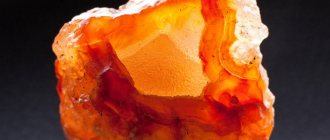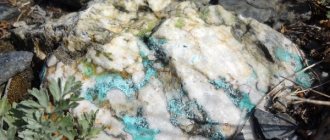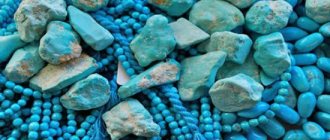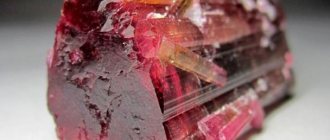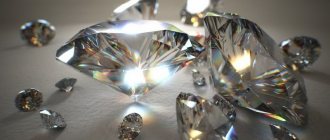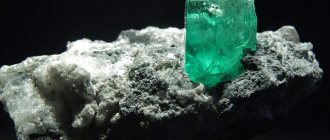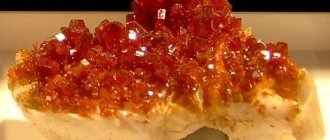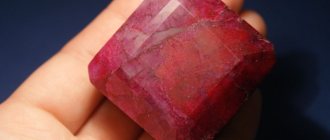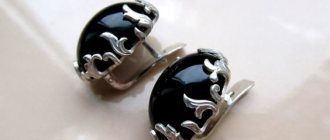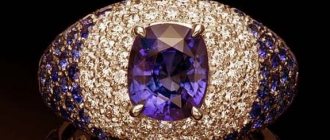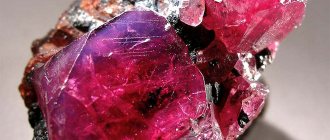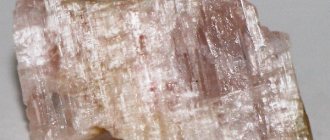Turquenite is a natural mineral with a not very happy fate. He had a hard time dressing up as natural turquoise. This is despite the fact that it itself is quite attractive, lends itself well to processing, and has a funny pattern in the form of black veins on a light gray background.
It looks very interesting in jewelry, costume jewelry and crafts. But it so happened that it was one of the new minerals, and the reserves of turquoise on earth were noticeably depleted.
History and description
The name of the mineral is derived from its resemblance - after coloring - to the favorite stone of the East: the international name for turquoise is turquoise.
Externally, turkenite and turquoise are indeed very similar.
Turkenite is opaque, moderately shiny blue-blue agglomerates with black or dark gray veins.
Although the original colors of magnesite are not particularly presentable: off-white, gray, yellowish. But after treatment with copper oxide dyes, the nugget is magnificent. The porous structure of magnesite contributes to this, absorbing paint like a sponge.
Marketers call several gems turkenite:
- imitation turquoise (fortified, refined);
- colored magnesite;
- colored howlite.
Therefore, the terms “blue howlite” or “blue magnesite” are also used to designate such samples.
Varieties of color
Howlite has different shades. The most common color is gray. These stones are characterized by black or brown veins. Sometimes you can find yellow gems that shimmer beautifully in the sun. White howlite is also found.
Gems are often painted in different shades. Carefully polished stones, painted gray, are a real work of art. Red-brown gems look very warm and elegant.
You need to choose a color depending on your goals. Jewelry can be turquoise or coral. At the same time, it is permissible to use only natural stones for magical and healing purposes.
Physico-chemical characteristics
For a chemist or physicist, the mineral turkenite is colored magnesite, that is, magnesium carbonate.
| Formula | Ca2B5SiO9(OH)5 |
| Color | White gray |
| Stroke color | white |
| Shine | Silky |
| Hardness | 3,5 |
| Density | 2.5—2.6 g/cm³ |
| singonia | Monoclinic |
This is a raw material of hydrothermal or sedimentary origin with a simple formula and the same composition.
How to distinguish howlite from turquoise and fake
Howlite is considered an interesting mineral that can be passed off as other gems. At the same time, turquoise, which is often imitated using this mineral, is much more expensive. Therefore, there is a risk of buying howlite at the price of turquoise, but not vice versa.
However, there are many differences between these minerals. Howlite costs about 150 rubles per 1 carat, and turquoise costs about 300. In addition, turquenite has less weight and a softer structure. It can be easily scratched.
To distinguish a gem from a plastic fake, you should use an ultraviolet lamp. Natural stones are almost never perfect. Under the rays of the lamp, you will be able to see the grains of inclusions that have a white or golden sheen.
Howlite is considered a relatively new mineral, which has gained popularity among many girls. Jewelry with this gem is suitable for almost everyone. It is important to learn how to properly care for them.
Where is it used?
Painted magnesite has found application in the jewelry and ornaments industry.
Its main mission is to replace expensive natural turquoise. The range of products is wider than turquoise; craftsmen make all types of jewelry. Polished inserts of rings, earrings, brooches or beads acquire an oily shine.
Ring with turkenite
The dimensions of the stone allow you to create small plastic pieces, carve balls, pyramids, and other esoteric paraphernalia.
Collectors of mineralogical collections are only interested in turkenite as a curiosity, a man-made variety of magnesite.
Howlite products
Howlite is a semi-precious stone that is used to make talismans and amulets. It is chosen by people who want to develop good qualities in themselves. The mineral helps to maintain dignity in any circumstances. Talismans are usually made from white stones. After polishing, the gem can be carried in your pocket or bag.
Howlite is also often used in jewelry practice. Gem jewelry has an affordable price. White varieties of the material are used to create luxurious products.
The material goes well with various metals - silver or gold plated. Jewelers often use howlite to create costume jewelry. The gem is suitable for making beads and bracelets. It is also used to make figurines and interior decor.
How to care
The stone is fragile and has low hardness on the Mohs scale, so you need to care for it carefully:
- Select a separate box (only adjacent to turquoise or howlite is acceptable).
- Protect jewelry from falls, heat, cold, and temperature changes.
- Do not wear to the beach, pool, sauna.
You should clean your jewelry with warm water without soap. And do not delay the procedure: the stone does not like long contacts with liquids. Ultrasound and steam cleaning are prohibited.
Who is suitable according to their zodiac sign?
Many people are interested in who this stone is suitable for according to their zodiac sign. Despite its purity and positive energy, the gem is not compatible with all signs. This mineral is forbidden to be worn by Aries, Leo and Sagittarius. For representatives of these signs, the stone can bring sadness, apathy and grief. Their life may become dull and uninteresting.
At the same time, Howlite has excellent compatibility with Scorpios, Virgos, Taurus and Capricorns. The mineral saturates these people with vital energy and helps them achieve their goals. The gem shows indifference to other signs.
How to recognize an imitation
Turkenite looks like real turquoise, so it appears on the jewelry and handicrafts market as its imitation. This option is conditionally considered a fake, since the base is still natural stone, painted with copper-containing dyes, and not plastic.
Moreover, since 2004, “turkenite”/“turquenite” has been used to refer to strengthened (that is, created from crumbs) or refined turquoise, as well as howlite stone.
This mineral can be distinguished from turquoise: turquoise is never large and lacks a porcelain shine.
It is easy to distinguish plastic due to its lightness and clearly noticeable warmth.
Turquoise. Learning to distinguish natural stone from artificial
It’s a wonderful time for us today – a “turquoise” week! And there have already been publications about turquoise, but I would like to share with you some practical aspects of knowing this amazing stone. So, many jewelry makers have probably thought more than once about the issue of the naturalness of the materials they purchase for their work. And often, unfortunately, the conclusion is not in favor of naturalness... alas! But, as we know, he who is informed is armed. So I suggest arming yourself with knowledge.
Modern fakes and imitations of turquoise are very artistic, and there are a large number of them.
Natural turquoise differs from minerals and other materials that imitate it in physical properties ( hardness, density, color, luminescence, waxy luster, etc. ). Under a microscope, the surface structure of natural turquoise has a characteristic appearance: dark blue disks or whitish fragments and inclusions are observed against a light blue background.
In synthetic turquoise, at high enough magnification, angular blue particles are observed against a lighter background. The absorption line characteristic of natural turquoise is absent in the absorption spectra of synthetic turquoise and imitations. The hot needle test can reveal refined turquoise: where the hot needle touches, paraffin melts or the stone becomes discolored. Plastics and resins melt from the hot needle. Synthetic turquoise differs from natural texture (under a microscope) and a different nature of interaction with dilute HCl.
Since turquoise is characterized by a fairly wide range of physical properties, it is identified by a comprehensive study using X-ray, spectral (in the IR and visible regions) methods and electron microscopy (lamellar-prismatic microcrystals are observed).
Today, artificial turquoise is used most often for jewelry. It is made from copper aluminophosphates, colored synthetic plastics and ceramic materials with coloring additives (sometimes natural turquoise waste is used as additives), and also imitates chrysocolla, variscite and blue-dyed howlite.
The situation is especially difficult (with regard to determining imitation and counterfeiting) with turquoise, since it is counterfeited not only by surface coloring of plastics and gypsum, but also by coloring similar minerals, for example howlite and various quartz. Now they have even learned how to create synthetic turquoise, which is very similar in composition to natural one, and even experienced gemologists cannot accurately identify it. So, first, you need to carefully examine the holes (turquoise is porous): if the material inside the hole is white, it is a fake. You can rub the stone with a damp cloth and see if the paint remains on the fabric, but this is not very reliable - the dye may be strong. Or try rubbing thoroughly with a cotton swab soaked in alcohol. If the stone is painted, the fleece will get dirty. But this method reveals only superficial cheap paintwork. You can hold turquoise over a match: if it turns black and melts, if a characteristic plastic smell appears, then it is plastic disguised as turquoise. All actions must be carried out on the back side of the stone, since the check usually leads to damage to the stone. Try scratching the turquoise with a needle. If the stone is not scratched, but the needle rubs off on it, then you are most likely looking at an imitation made of faience, glass or chalcedony (when the hardness of the stone is more than 5.5 according to Mohs, turquoise cannot have this). If the turquoise is scratched too easily by shavings or white powder, it is plastic. The white stripes under the top colored layer are also questionable, since natural turquoise is colored throughout its entire depth. Heat the needle and touch the stone. On treated turquoise (dyed, impregnated with resins or wax), the color will change at the point of contact or a drop of impregnation will appear. Plastic imitations will begin to melt with a characteristic smell of burnt plastic. Odontolitis emits a burnt bone smell. A good criterion for the “naturalness and authenticity” of turquoise is its size and price. A size of more than half a centimeter is already quite large inserts, they indicate that this is either a pressed crumb or an imitation. Remember that natural turquoise for jewelry is a rare and expensive mineral; moreover, it is found in nature only in small pieces; it is unlikely that it will be used to make beads or earrings. The price of a product, even with a small insert of natural turquoise, starts at an average of $200; anything cheaper is not turquoise! Real turquoise is quite expensive. And it is very difficult to buy it because of its rarity: almost everything that is sold in stores is an imitation, with rare exceptions. As already mentioned, bones or teeth of fossil animals can also serve as a substitute for turquoise. They are colored with iron or copper salts. When dyed with iron, the color turns out to be blue, and green will appear if dyed with copper. Such bones are well cut, polished, and products made from them are often sold as turquoise. So, if you see such an incomprehensible name - bone turquoise, or western turquoise, rest assured that this has little to do with natural turquoise. Today there are many natural stones sold under the guise of turquoise. The most commonly offered are chalcosiderite, aluminochalcosiderite, raschleite, fostite (faustite), vardite, variscite, chrysocolla, dontolite, stellarite, etc. Many of them are inferior in quality to turquoise. Often offered from the USA, quartz and colored chalcedony are clearer and have a lower density. Imitation made from natural stones is the best imitation of turquoise. Some of the “analogue backups” have good characteristics. For example, turquenite (the trade name for colored howlite) is a very worthy substitute for turquoise (its deposits are greatly depleted); in some characteristics it surpasses even refined turquoise. It does not crack when heated, does not change color, and is not afraid of water and light. In essence, turquenite differs from turquoise only in its porcelain shine (as opposed to the waxy or silky shine characteristic of natural turquoise). Variscite and lazulite Variscite and lazulite are minerals similar to turquoise; They are both hydrous aluminum phosphates but do not contain copper. The density of lazulite is 3.1 g/cm3 (more than that of turquoise), hardness - 5.5, refractive index 1.61 - 1.64. Lazulite is sometimes called "bluespar". Unlike cryptocrystalline turquoise, it is represented by a fine-grained material. Variscite has a density of about 2.4, hardness - 4 - 5, refractive index up to 1.57. Color: green, dark green, blue, yellow. Glass shine. Forms crusts, nodules, and rarely octahedral crystals. There is no cleavage. The most common varieties of variscite develop in the form of eyes, which is not typical for turquoise. High quality variscite is as rare as good turquoise, if not rarer. Colored minerals: Colored howlite is silicoborocalcite, lighter and softer than turquoise. The color of the painted material can be very bright, its price is much lower. Dyed quartz and chalcedony are materials that are significantly cheaper than turquoise and are offered by American suppliers. These stones are more transparent than turquoise, lighter (density 2.63 g/cm3), with a lower refractive index - 1.53 and greater hardness (6.5 - 7).
All colored minerals can be distinguished from natural turquoise by their weight. Natural porous turquoise is distinguished by its amazing lightness.
Organic compounds.
Odontolitis. In the past, turquoise was often passed off as odontolite—fossil ivory, fossilized teeth, or fossil animal bones partially replaced by iron or copper phosphates and colored blue or green. Externally, the material is very similar to turquoise. The refractive index of odontolite is 1.57 - 1.63. Hardness 5. Density above 3 g/cm3. Boils from hydrochloric acid. The primary organic structure of the mineral is visible in thin sections. A reliable way to separate turquoise from ornamental materials of organic origin is the ability of organic matter to burn.
Artificial Minerals and Materials: Successful counterfeits are made by pressing a precipitate of aluminum phosphate, colored blue with copper oleate, as it has almost the same appearance, hardness and density as turquoise. Unlike natural stone, artificial material melts in the flame of a blowpipe. “Vienna turquoise” is an imitation obtained by joint crushing, heating (more than 100°C) and pressing a mixture of malachite, aluminum hydroxide and phosphoric acid. The formula of this material is different from turquoise. The hardness of pressed turquoise is about 5. Density is 2.4, when saturated with water it increases to 2.6 g/cm3. Refractive index 1.45. When heated, this fake blackens or fuses into black glass rather than cracking like turquoise. “Synthetic turquoise” (Neolithic) - common since 1957. The stone has a pleasant blue color, sometimes with sinuous veins of the “ground mass”. It is a mixture of bayerite and copper phosphate, and the bulk is an amorphous iron compound. Bayerite is a by-product of aluminum production, similar in composition to hydrargillite. Hardness about 4. Refractive index 1.55. Density 2.4 g/cm3. Almost Neolithic is identical to Viennese turquoise. Artificial turquoise , consisting of small grains of blue and white material cemented with alkyd resin, was created in 1953 in America. The hardness of this turquoise is about 2.5. Density 1.85 g/cm3. In some samples, the hardness reaches 3.5 and the density 2.39 g/cm3. Glass and enamel were first used as imitations by the Egyptians 5 thousand years BC. e. to obtain a material similar to turquoise. Blue glass beads were found in the tomb of Tutankhamun (1350 BC), they were colored with cobalt. Modern glass beads are also made to look turquoise. Enamels that imitate turquoise are slightly discolored silicate glass mixed with a mixture of metal oxides. Most glass imitations have a higher density compared to natural turquoise. A doublet made of chalcedony and glass is also often passed off as turquoise. Plastic is, of course, the cheapest imitation of turquoise . Cabochons are cast from it, sometimes with a cobweb pattern characteristic of turquoise. But the coloring of plastic products is too perfect. They are lighter, softer, non-porous and without the characteristic waxy sheen; on the contrary, they have a glossy shine. When using colloidal silica as a binding mass, the density of the resulting material is 2.65.
If you look from a magical point of view, then mystical properties are characteristic only of imitations of turquoise in natural stone. However, a painted stone retains only its own properties; it does not acquire the properties of turquoise.
I would like to add that no one has canceled honesty and urge sellers of materials to give as truthful a description of a particular stone as possible, even if these are obvious things to you. At the beginning of my career, I encountered an unpleasant situation when, out of ignorance, I bought an opalite pendant (however, quite a beautiful pendant!), believing that it was a natural adularia (moonstone). I had reason to believe so, since this pendant was in the “natural stones” section and was called “moonstone”. When I figured it out and turned to the seller (with a request for clarification), I heard something like this in response: “Didn’t you know? Yes, this is the trade name of opalite! Yes, at that time I didn’t know, but the trade name itself cannot deceive, and it is the person, the seller, who is misleading, who knows, but for some reason does not explain to naive citizens that this is an imitation.
I am sure that I have not discovered anything new for experienced craftsmen, but I will be glad if the material turns out to be useful to someone!
Based on the article: “How to distinguish natural turquoise from imitation?”
Thank you for your attention, best regards, Anna.
Magic properties
Esotericists have discovered the following magical properties of turkenite:
- Suitable for people who want to start a family.
- As a talisman it is indicated for hyperactive children.
- Normalizes relations between representatives of different generations of the family.
- He is taken as a mascot to auditions, exams, and interviews.
- Protects the owner from dangers outside the home, which is appreciated by everyone whose work requires frequent travel. For example, truck drivers, travelers, geologists, crews of long-distance vessels.
- The nugget is placed at the entrance to the house as a talisman against natural disasters and uninvited guests.
You need to choose a talisman stone carefully: the magic of imitation will be zero.
Impact on humans
More recently, a white gem in its natural form has come into fashion. In addition to the fact that the stone looks advantageous and laconic in products made of cupronickel and silver, it retains its energy. Owners of jewelry with turquenite, for whom the stone is suitable, note its properties. The gem is able to influence the psychological and physical state of a person.
Lithotherapists often use howlite in their work, using its healing qualities. The stone is capable of:
- Strengthen bone tissue and joints, improve the general condition of the musculoskeletal system.
- Get rid of toxicosis in pregnant women.
- Help the baby develop properly in the womb.
- Normalize blood pressure.
- Relieve muscle pain.
- Strengthen the immune system.
- Reduce bad cholesterol.
- Restore masculine strength.
- Relieve toothache.
- Ease menopause.
- Help with childbirth.
- Normalize the functioning of the cardiovascular system.
- Improve the functioning of the gastrointestinal tract.
It has been noticed that caulite helps to recover faster from fractures due to its high calcium content.
Massage with howlite balls removes cellulite, fights varicose veins and rheumatism. Wearing beads, earrings or a ring with a gem will help cure depression and insomnia, and restore the body after illness and stress.
